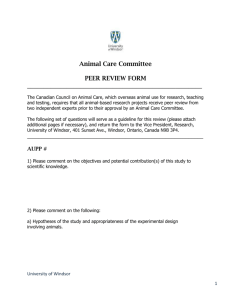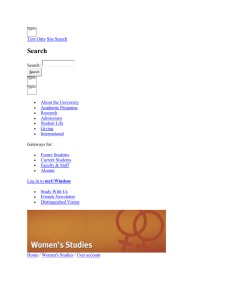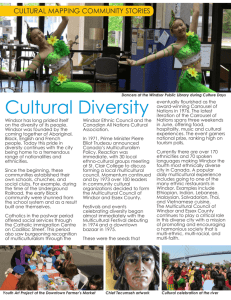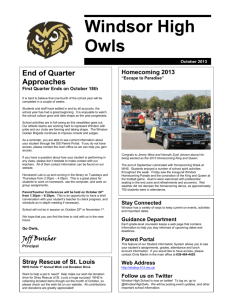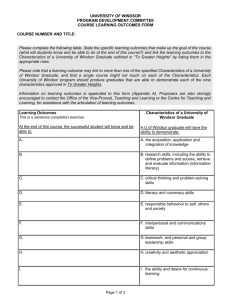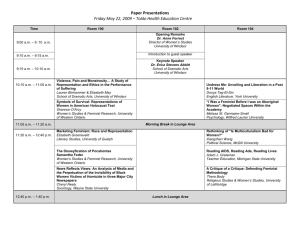(1918) - May 25, 2015 - University of Windsor
advertisement
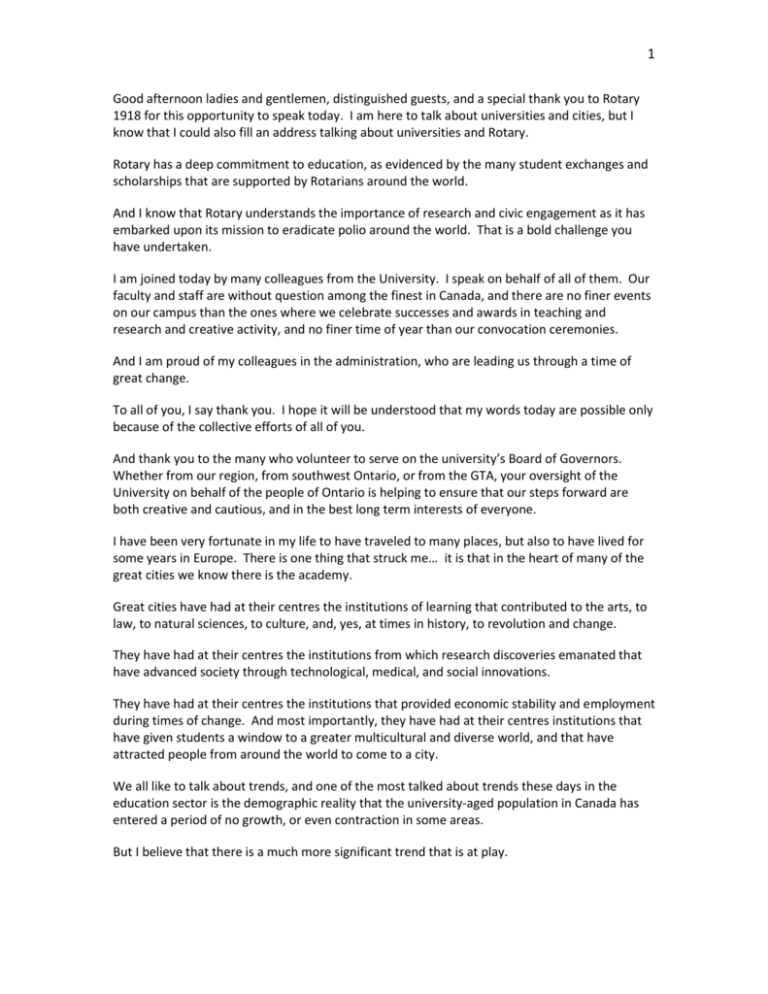
1 Good afternoon ladies and gentlemen, distinguished guests, and a special thank you to Rotary 1918 for this opportunity to speak today. I am here to talk about universities and cities, but I know that I could also fill an address talking about universities and Rotary. Rotary has a deep commitment to education, as evidenced by the many student exchanges and scholarships that are supported by Rotarians around the world. And I know that Rotary understands the importance of research and civic engagement as it has embarked upon its mission to eradicate polio around the world. That is a bold challenge you have undertaken. I am joined today by many colleagues from the University. I speak on behalf of all of them. Our faculty and staff are without question among the finest in Canada, and there are no finer events on our campus than the ones where we celebrate successes and awards in teaching and research and creative activity, and no finer time of year than our convocation ceremonies. And I am proud of my colleagues in the administration, who are leading us through a time of great change. To all of you, I say thank you. I hope it will be understood that my words today are possible only because of the collective efforts of all of you. And thank you to the many who volunteer to serve on the university’s Board of Governors. Whether from our region, from southwest Ontario, or from the GTA, your oversight of the University on behalf of the people of Ontario is helping to ensure that our steps forward are both creative and cautious, and in the best long term interests of everyone. I have been very fortunate in my life to have traveled to many places, but also to have lived for some years in Europe. There is one thing that struck me… it is that in the heart of many of the great cities we know there is the academy. Great cities have had at their centres the institutions of learning that contributed to the arts, to law, to natural sciences, to culture, and, yes, at times in history, to revolution and change. They have had at their centres the institutions from which research discoveries emanated that have advanced society through technological, medical, and social innovations. They have had at their centres the institutions that provided economic stability and employment during times of change. And most importantly, they have had at their centres institutions that have given students a window to a greater multicultural and diverse world, and that have attracted people from around the world to come to a city. We all like to talk about trends, and one of the most talked about trends these days in the education sector is the demographic reality that the university-aged population in Canada has entered a period of no growth, or even contraction in some areas. But I believe that there is a much more significant trend that is at play. 2 In 2006, the world crossed a tipping point at which the number of people living in urban settings equaled the number living in rural areas. Since that year, the trend has continued, and today close to 60% are urban. In Canada this trend has been even more pronounced. The 50% tipping point was reached in 1925, and today close to 85% of the country is urban. I know that this trend is very much a concern for mayors of cities across the country, who feel that civic governments are playing an increasingly important role in our future. To not embrace the fabric of a city, and to not recognize more than ever the importance of the academy being a visible and engaged part of the city… that will be to deny students full engagement with what increasingly are the places that will determine our future on this planet. Many scholars ranging from sociologists to urban geographers have studied the complex interplay between a university and community within which it exists. Books have been written about it. It is no coincidence that cities that do not have a university want one. This past year the province of Ontario issued a call for proposals for new university campuses, and communities across the province reached out to existing universities to see if they would be interested in opening a new campus in a city where one does not exist. At the same time, as cities begin to dominate the course of our trajectory on this planet, there is something about the historical positioning of the academy in the heart of cities that increasingly resonates with the duty of the academy, through education and research and creativity, to contribute to a better world. The time has never been better for universities to take heed of the words of Albert Einstein, “strive not to be a success but to be of value”. To do that, a university must be willing to contribute to helping a community change, and it must be willing to itself be changed in response to what the community needs. There is absolutely nothing preventing us, the University of Windsor, from being among the finest and most unique universities in Canada. As far as communities are concerned, we are located in one to be truly proud of. This audience knows that Windsor-Essex has contributed to the wealth and culture of our nation for over a hundred years. In benefitting from the name of Windsor, I also want to underscore that our university also values the extensive connections with Tecumseh, LaSalle, Lakeshore, Essex, Amherstburg, Kingsville, and Leamington. Our university is in a very real way the distillation of aspirations and successes across Windsor-Essex. With over 35,000 alumni across Windsor-Essex, Chatham, and Kent, we know the university’s impact has been great, and we know that our duty to make all of you proud is large. 3 There are those who sometimes think that the reputation of the University of Windsor is hampered by the perceptions of the community we live in. I think this is hogwash and defeatist. The Windsor name is one we should celebrate, embrace, and promote. A degree from the University of Windsor, Made in Windsor, should be celebrated in the tradition with which this community celebrates the high achievements it has made in manufacturing, agriculture, labour movement advocacy for social change, health care, the arts and more. There is not a day goes by where I do not see something someone has done to make this community a better place. This is the perfect backdrop within which a university, our university, can be an institution of higher learning that embraces a city, that becomes a better educational institution because the city and its many enterprises become partners in education, and that gives our students more and richer opportunities to connect the classroom to the future. Every university and college in Ontario recently was asked by the province to develop a Strategic Mandate Agreement. In it, we were asked to demonstrate our strengths and where we thought we had the greatest opportunities to make an impact. The University of Windsor’s Strategic Mandate Agreement builds directly on our desire to be a university where teaching and learning are at the leading edge, where our campus is redeveloped to facilitate engagement with the resources and talents and needs of our community, and where we draw greater attention to four grand challenges that our scholars and students can address. These four grand challenges are ones that are nationally and internationally recognized, particularly in a world increasingly dominated by cities. First, they include the challenge of sustaining the health of the Great Lakes, the world’s largest freshwater supply and a resource that will shape the health of our cities and the production of our food. Second, they include the challenge of contributing to the health and well being of communities, particularly as communities are entering a more complex and challenging era where postindustrial realities, faded dreams, new opportunities, and new hopes live side by side. Third, they include a commitment to work with industry and manufacturing sectors to help them innovate and succeed. This is in recognition of the reality that if a country stops making things that people want to buy, its wealth will ultimately be drained. And fourth, they include a commitment to help us understand borders, and how the movement of people and goods across them is shaping international trade and international relations. There is no better university in Canada to address these four challenges. There is no better community within which to give students opportunities to truly make a difference. There is no better place for a community to be a partner in education. Let me share a few stories about the university. 4 The Cross-Border Institute at the University of Windsor, led by Prof. Bill Anderson, has collaborated with the City’s Traffic Operations Division on the installation of radar sensors to provide real time data on the flow of trucks in both directions across the Ambassador Bridge. These sensors will contribute real time information to cross-border logistics efforts, with the goal of reducing supply chain costs and enhancing the competitiveness of our regional economy. The university is in discussions with the Windsor-Detroit Bridge Authority as it begins its work on the Gordie Howe International Bridge, with the Authority seeing great potential for our students and researchers to be involved in many aspects of this complex multidimensional project. The Institute for Border Logistics and Security (IBLS), led by Laurie Tannous, is a joint initiative of the University and the City, located at the Windsor airport. It is focused on the needs of the transportation and supply chain industry, and the support of businesses engaged in the movement of goods and people across the Border and around the world. The IBLS will be the testing ground to put into action the results of ongoing Cross-Border Institute research on border security and logistics. It is also developing Internet “e-guides” on cross-border business travel, and will soon have a website providing free templates for border procedures. The University of Windsor and St. Clair College have entered into discussions about developing a collaborative diploma/degree program in Supply Chain and Logistics. And on the topic of St. Clair College, I congratulate Patti France on her appointment as the next President of the College. I look forward to working with her on the many exciting collaborative opportunities that exist between the College and the University, as she builds upon the exceptional successes of Dr. John Strasser. Among those successes is the exciting footprint that St. Clair College has already established in the heart of Windsor. The University of Windsor Enactus student club, comprised of 120 students primarily from the Odette School of Business, but other Faculties as well, runs a program called City Thrive. This program is in partnership with the City of Windsor's Social Services Department in which the City selects participants who are on Ontario Works, and who want to start their own business. The students hold sessions with them on business fundamentals such as defining their target markets and pricing, setting up their books to do income statements and developing their balance sheet, using social media and other marketing techniques and assisting them in finding their first customers. Each participant leaves with a complete business plan and a list of action steps. Over the three years that this program has been in operation there have been 29 participants of which 9 have left social assistance, saving the City $340,000 to date. 5 The Town of LaSalle has partnered with our Great Lakes Institute for Environmental Research to build a Fish Research Centre on the waterfront in LaSalle. Prof. Trevor Pitcher, along with more than a dozen other researchers on campus, and a growing list of graduate students, are using this facility to advance our understanding of fish species within the Great Lakes. Mayor Ken Antaya of LaSalle and I met last week, along with his staff and some of our researchers, as the town finalizes plans to expand the facility for our use, including creating more space that can be used for community education programs. Our Psychological Services and Research Centre, under Director Prof. Antonio Pascual-Leone, along with a number of professional faculty and staff, offers Child-Adolescent and Adult Assessment Services for families across Windsor-Essex. These services significantly expand the opportunities for clinical psychology trainees, and help to make our Clinical Psychology Program one of the best graduate programs of its kind in Canada. This is only a very, very small set of examples of university-community engagement. To the many, many people across every one of our Faculties, I apologize that I do not have time to list all that you are doing. Collectively, you are all intertwining our university and our education and research programs in ways that are truly making our community a vital and valued partner in fulfilling our Strategic Mandate Agreement. We are a university with growing regional relevance and an expanding international base, with 16% of our students now coming from elsewhere in the world. Where we, like all universities, worked with books and lectures, we now have added to these new pathways for degree completion, experiential learning, on line learning and more. In the last two years we have received almost $1M of competitive funding from the province for online and blended course development. Included in this are fourteen university-college collaborative online course development projects. We currently have 10,000 online enrolments per year. For so many reasons I have talked about, the University of Windsor has the potential to be a university of exceptional distinction. Our complex blend of programs, our diverse and international character, the focus of our research and creative activity on things that matter, and most importantly, the grittiness and passion that are embedded in our history and the history of Windsor-Essex, are all exceptional strengths. Second, I want to talk about the physical development of our campus, and how both the SunsetWyandotte address and the downtown Windsor address are being shaped to facilitate the future of education and deeper engagement with our community and many partners. On our main campus, our new Ed Lumley Centre for Engineering Innovation is a spectacular space that is designed to engage industry. The research facilities, the industrial courtyard, and the advanced technologies in the classrooms, have created a unique asset for the region. 6 Since the opening of the building four years ago, enrolment in engineering programs has risen by 60%. This has exceeded our most optimistic expectations, and underscored the importance of appropriate facilities for attracting students. We are proud that the Windsor-Essex Economic Development Corporation has its home, and its own distinctive address, in the building. Adjacent to the engineering building and the Odette School of Business is the new Joyce Entrepreneurship Centre. Our entrepreneurship practice and innovation centre, or EPICentre, occupies much of the second floor, and provides space for students to explore their own entrepreneurial ideas with the support of mentors who have business or entrepreneurial experience. Every university I know is creating space for student entrepreneurs, and without question the space we have on our campus ranks among the best. The new Welcome Centre is about to open this summer, and it will provide an inviting gateway for prospective students. It will house our student recruitment office, alumni office, and public affairs and communication office. If you have not yet seen it, I encourage you to go by and take a look. It, along with a Sunset Avenue corridor that is now closed to traffic and undergoing conversion to a pedestrian way, will make our main campus feel much more like a campus, and create a much stronger sense of place for our students, faculty, staff, community, and visitors. But the boldest new physical change to our campus is beginning to unfold in downtown Windsor. The downtown campus is the clearest manifestation of the goal of aligning our education and scholarly capacity with the community, and positioning our students in an environment where they can best discover what their education can mean for their future. It is the repatriation of the historical precedent of the academy being integrated into the heart of a city. It is the landmark that demonstrates the commitment of the University of Windsor to help shape the future of a city, a city that like many others is at the bow of the ship in changing global seas. This would not be happening if the City of Windsor did not share our belief in the importance of the University to its future. To former mayor Eddie Francis and past members of council, you have helped lay a new foundation to the future of the city centre. To current mayor Drew Dilkins and current council, your continuing belief in this vision continues the story of how a city can make a difference. There are examples around the world.. Pittsburgh, Newcastle.. cities around the world have reimagined themselves by building on the tradition of the academy being a part of them, and aligning their creativity and resources with a university to become better and stronger cities. There are three zones in our downtown campus… the future home of our School of Social Work and Centre for Executive and Professional Education, at the site of the former Windsor Star building; the future home of our School of Creative Art, at the site of the Armouries and the 7 former Tunnel BBQ; and the future home of a centre to foster University/Community engagement, at the site of the art deco Greyhound bus depot and the parkette adjacent to it across Chatham Street. Let me say a bit about each of these. The Windsor Star property was acquired from Postmedia through negotiations with Marty Beneteau at the Windsor Star. Despite what everyone still says, we are not renovating the three original elements of the building. They are gone, and all that remains is the beautiful historic walls that are the landmark features our community will now have as permanent fixtures of the downtown. The new building will feature a heritage courtyard where the original 1918 wing stood. It is fitting that I announce this at a Rotary 1918 meeting. And there will be room for future expansion. Within the new building will be dramatic and inspiring spaces that showcase the extraordinary two story windows of the historic corner. And on the rooftop will be a glassed in and open terrace with a view of the river and Detroit skyline. But more importantly, when it opens this September, this address will change the experience for our students and community with respect to Social Work. The building includes interview rooms to provide social work students with the opportunity to experience the professional practice of interviewing clients. The interview rooms are a new facility unavailable at most Schools of Social Work in Ontario. In addition, meeting rooms in the new buildings will enable students enrolled in our undergraduate and graduate programs with new opportunities to engage in group work to build their skills in professional interactions and team work. And importantly, the building positions our students and faculty and staff closer to the many agencies and services that support communities of need. Our School of Social Work’s efforts in the Glengarry Housing Project, and the engagement with the many organizations that provide mentorship for our trainees, have earned our School the highest accolades from all levels of government. And then there is the School of Creative Art, centred around the Armouries and former TBQ site. The City’s contribution of the Armouries, and $10M, was a critical catalyst in enabling this project to happen. For Windsorites with a sense of humour, the Nut House will like the TBQ building become a part of our fond memories of the downtown. 8 I welcome guests here today who have a direct history with local regiments and the Armouries. The value of service of our country can not ever be taken for granted. This building was built to support the men and women in service of our country. As it transforms into a hub of learning and creativity, it will continue to be in the service of our country. For those of you with inside knowledge of the building, we are making efforts to preserve Old Bill, and to reuse some of the historic doorways and other features. And we are adding a basement. When this project is completed in 2017, emerging from the Windsor-Detroit tunnel you will see a new vista down Freedom Way. The former Greyhound Bus Depot will be at the end of Freedom Way. It will not be a part of the School of Creative Art, but will be a facility for the University as a whole. We are still finalizing the plans for it, but we want it to be a place where the community can come together to experience the many things the university is doing. But like all of the buildings, it is about our students. The new location for the School of Creative Art will allow us to do some things we couldn’t do. We will have 3D and electronic fabrication downtown. We will have performance spaces for both planned and spontaneous events. In particular: the amphitheatre area in the Armouries will function as a gathering space and site for all kinds of inter-arts activity. The Performance Hall will offer a concert-like venue for music students to practice in. And you will be able to see us: we have used glass wherever we can so that other students and community members can witness what we actually do. And Music and Visual Arts students will literally be bumping into each other. They will hear each other and see each other's work: this will lead to all kinds of collaborations we could never have imagined. The downtown campus is a major capital investment for downtown Windsor, totaling close to $75M. It is a new chapter in the history of the University of Windsor, and a new chapter in the downtown. We remain very open to the possibility that future opportunities may exist in the city core that would enable us to further fulfill our Strategic Mandate Agreement. 9 Whatever the University of Windsor does, it must first and foremost be in the best interests of our students. What is wonderful about this city and region is its potential to find even more ways to work with us to contribute to that goal. I would close with the following. In three weeks we will have our convocation ceremonies. Increasingly, our entire city and region should be able to feel the pride, feel the energy, feel the optimism, that comes with seeing students succeed. And the more we work together, the more likely it will be that more of that success will stay in our city and region. Thank you to Rotary 1918. I truly appreciate the opportunity to be here today.
